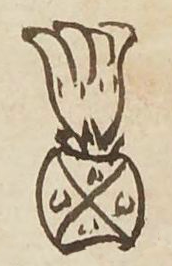Yaoxochitl (MH485r)
This black line drawing of a compound glyph for the personal name Yaoxochitl has two main elements. One is a war shield, standing for yaotl (enemy) or yaoyotl (warfare). The other is a flower (xochitl). The shield is rounded on the sides, but has depressions on the perimeter at top and bottom. The shield is divided into four sections with an X-shaped cross. Inside each section is what appears to be a u-shape. The flower is upright and left natural (no coloring). It has a tripartite sepal that would have connected to a stem, some texturing, and perhaps four petals at the top.
Stephanie Wood
Frances Karttunen says that this name means "Enemy Flower" or "War Flower," and it is a type of flower as well as a personal name. Magnus Pharao Hansen adds that this was a name for the marigold. [See his blog from 2014, "Nahuatl Names: The Nahuatl names in the 1544 census of Morelos."]
Stephanie Wood
Juā yaoxochitl
Juan Yaoxochitl
Stephanie Wood
1560
Stephanie Wood and Xitlali Torres
wars, shields, coats of arms, armas, escudos, guerra, flores

Yaoxochitl, a type of flower, a name, https://nahuatl.wired-humanities.org/content/yaoxochitl
yao(tl), enemy, https://nahuatl.wired-humanities.org/content/yaotl
xochi(tl), flower, https://nahuatl.wired-humanities.org/content/xochitl
Flor del Enemigo, Flor de la Guerra
Matrícula de Huexotzinco, folio 483r, World Digital Library. https://www.loc.gov/resource/gdcwdl.wdl_15282/?sp=51&st=image
This manuscript is hosted by the Library of Congress and the World Digital Library; used here with the Creative Commons, “Attribution-NonCommercial-ShareAlike 3.0 License” (CC-BY-NC-SAq 3.0).


